Top 10 AI SDR Tools for B2B Sales Teams in 2025

Top 10 AI SDR Tools for B2B Sales Teams in 2025
By 2025, AI-powered Sales Development Representative (SDR) tools are transforming B2B sales, automating repetitive tasks, and improving outreach with data-driven insights. These tools use machine learning, natural language processing, and predictive analytics to help sales teams identify high-value leads, personalize communication, and manage multi-channel campaigns across email, LinkedIn, phone, and more. The result? Faster workflows, better engagement, and increased revenue potential.
Here’s a quick look at the top 10 AI SDR tools shaping B2B sales in 2025:
AI SDR Shop: A directory of over 50 AI-powered SDR tools, offering detailed comparisons and recommendations.
11x: Focuses on autonomous prospecting and predictive lead scoring for smarter outreach.
SecondBrain Labs: Limited information available; consult directly for details.
Persana: Automates prospect research and follow-ups with advanced personalization.
Cognism: Provides GDPR-compliant lead data and real-time intent signals.
Outreach.io: Centralizes sales workflows with AI-driven automation and multi-channel coordination.
SalesLoft: Offers 26 AI agents for revenue cycle automation and multi-channel engagement.
Drift: Uses AI chatbots to engage website visitors in real-time.
Apollo.io: Combines prospecting, automation, and analytics in one platform.
HubSpot Sales Hub: Integrates sales, marketing, and customer service with AI tools for personalization and forecasting.
These tools address key sales challenges like lead prioritization, personalized messaging, and multi-channel outreach. When choosing a solution, focus on features like automation, AI-powered insights, compliance with US regulations, and seamless integration with your existing systems.
Quick Comparison
| Tool Name | Key Strengths | Best For |
|---|---|---|
| AI SDR Shop | Tool discovery and comparison | Exploring SDR options |
| 11x | Predictive lead scoring | Advanced automation and scalability |
| SecondBrain Labs | Limited info available | Unknown |
| Persana | Personalization and lead scoring | Efficient prospecting |
| Cognism | GDPR-compliant data | Data-driven outreach |
| Outreach.io | AI-driven automation | Enterprise sales teams |
| SalesLoft | Comprehensive automation | Large-scale sales operations |
| Drift | Real-time website engagement | Inbound lead generation |
| Apollo.io | All-in-one prospecting solution | Small to medium-sized teams |
| HubSpot Sales Hub | CRM integration and forecasting | Unified sales and marketing workflows |
These tools cater to teams of all sizes and industries, offering solutions for every stage of the sales process.
13 Best AI Sales Tools & Agents 2025 (Ranking & Full Demo)
::: @iframe https://www.youtube.com/embed/rBsWo6rZ_zA :::
AI SDR Shop Overview
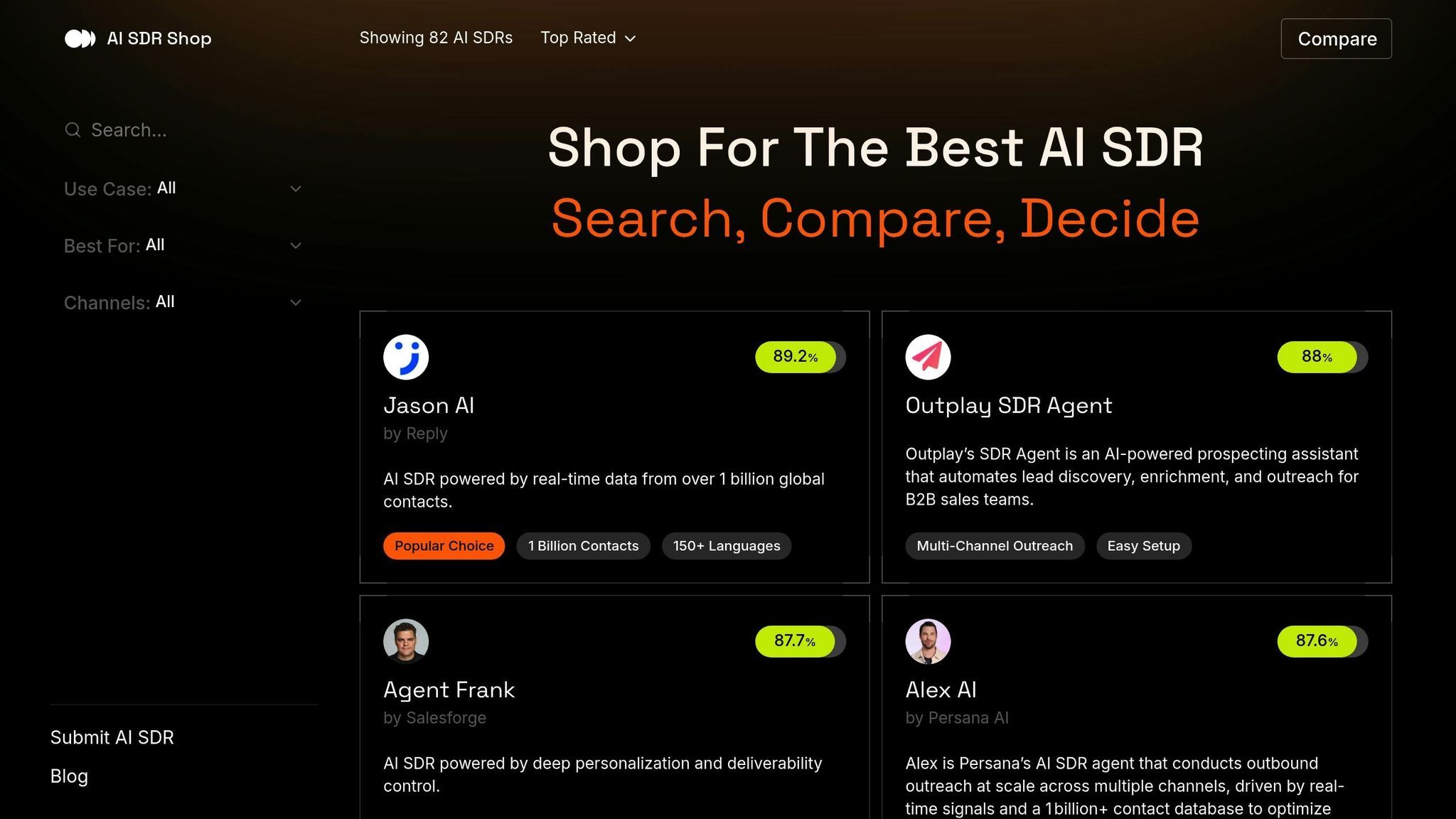
AI SDR Shop provides a streamlined directory designed to simplify the process of evaluating SDR tools for B2B sales teams. This free platform reshapes how businesses discover AI-powered SDR solutions, cutting down on the time and effort typically spent on research.
With profiles for over 50 AI SDR tools, the platform offers clear summaries of each tool's main features, integrations, and use cases, helping businesses find options that align with their specific needs.
The comparison tool is particularly useful, showcasing essential features like multi-channel outreach to ensure consistent messaging across platforms. Real-time data integration is another standout feature, demonstrating how each tool connects seamlessly with systems like CRM, marketing automation, and sales intelligence tools.
AI SDR Shop also dives into how these tools leverage buyer behavior data to identify high-intent prospects. It provides insights into customizable workflows, which range from straightforward email sequences to more intricate sales campaigns.
The platform even clarifies whether tools use their own email-sending capabilities or depend on third-party services. To top it off, it emphasizes human-led quality control features that strike a balance between automation and necessary oversight.
Key Features to Look for in AI SDR Tools
When choosing an AI SDR tool, it’s crucial to match its features with your business goals. Here’s what to keep in mind:
Automation Capabilities are a must-have. The best tools handle repetitive tasks like prospect research, outreach, and follow-ups. Look for features like adaptive lead scoring, automated email management, and built-in calendar scheduling to streamline your workflow.
Multi-Channel Outreach ensures your sales team can connect with prospects wherever they are. Whether it’s email, LinkedIn, phone, or text, the tool should unify these channels into seamless, personalized campaigns while tracking engagement across the board.
Lead Generation Efficiency is what separates the good tools from the exceptional ones. Tools that use machine learning to analyze behavior, growth trends, and buying patterns can identify high-intent prospects. Bonus points if the tool integrates multiple data sources and uses predictive analytics to prioritize leads.
AI-Driven Personalization takes messaging to the next level. Beyond basic mail merges, the top tools craft dynamic, personalized content using prospect data and industry insights. This includes customized subject lines and messages that feel authentic and relevant.
Data Security and Compliance can’t be overlooked in today’s sales environment. Ensure the tool adheres to GDPR and CCPA standards, offering features like encryption, secure storage, audit trails, and consent management to safeguard sensitive information.
Integration Capabilities are key to making the tool work seamlessly with your existing systems. Look for platforms that integrate directly with CRMs like Salesforce, HubSpot, or Microsoft Dynamics, as well as your marketing and sales tools. API access is also a big plus to avoid data silos.
Analytics and Reporting provide the insights you need to fine-tune your sales strategy. Opt for tools with dashboards that track metrics like response rates, conversion rates, and pipeline velocity. Advanced reporting features can also help pinpoint the best messaging and outreach timing.
Scalability and Performance are critical as your team grows. Choose a tool that can handle increasing prospect volumes without slowing down. Flexible pricing options for team expansion are another factor to consider.
User Experience and Training can make or break adoption. Tools with an intuitive interface, clear onboarding processes, and responsive customer support will help your team hit the ground running.
Customization Options allow you to adapt the tool to your specific needs. Look for features like adjustable email templates, workflow configurations, and tweakable AI settings to align the tool with your industry and sales methodology.
Next, we’ll dive into the top AI SDR tools that incorporate these features to transform your sales strategy.
1. AI SDR Shop
AI SDR Shop stands out as a go-to platform for discovering and evaluating AI-powered Sales Development Representatives (SDRs). Designed specifically for B2B sales teams, this curated directory offers access to over 50 AI SDR agents, each with detailed profiles. It simplifies the process of searching, comparing, and assessing tools, making it easier for sales teams to find solutions that align with their needs. Below are some key feature categories that highlight how AI SDR Shop supports B2B sales efforts.
Automation Capabilities
AI SDR Shop takes the hassle out of selecting the right tools by offering user-friendly search and comparison features. Thanks to real-time data updates, users can access the latest information on pricing, tool features, and integrations, ensuring well-informed decisions every step of the way.
Multi-Channel Outreach
The platform emphasizes multi-channel outreach by providing in-depth profiles that detail each tool's communication capabilities. This allows sales leaders to identify tools that align with their outreach strategies, whether through email, social media, or other channels.
Lead Generation Efficiency
AI SDR Shop prioritizes lead generation by showcasing tools equipped with intent-based lead identification. These solutions help sales teams zero in on high-quality leads, leveraging actionable insights to optimize their sales pipelines.
AI-Driven Personalization
Personalization is a key focus, and the platform highlights how each tool integrates AI to deliver tailored messaging. By blending AI precision with human-like quality, these tools help sales teams create more meaningful connections with prospects.
2. 11x
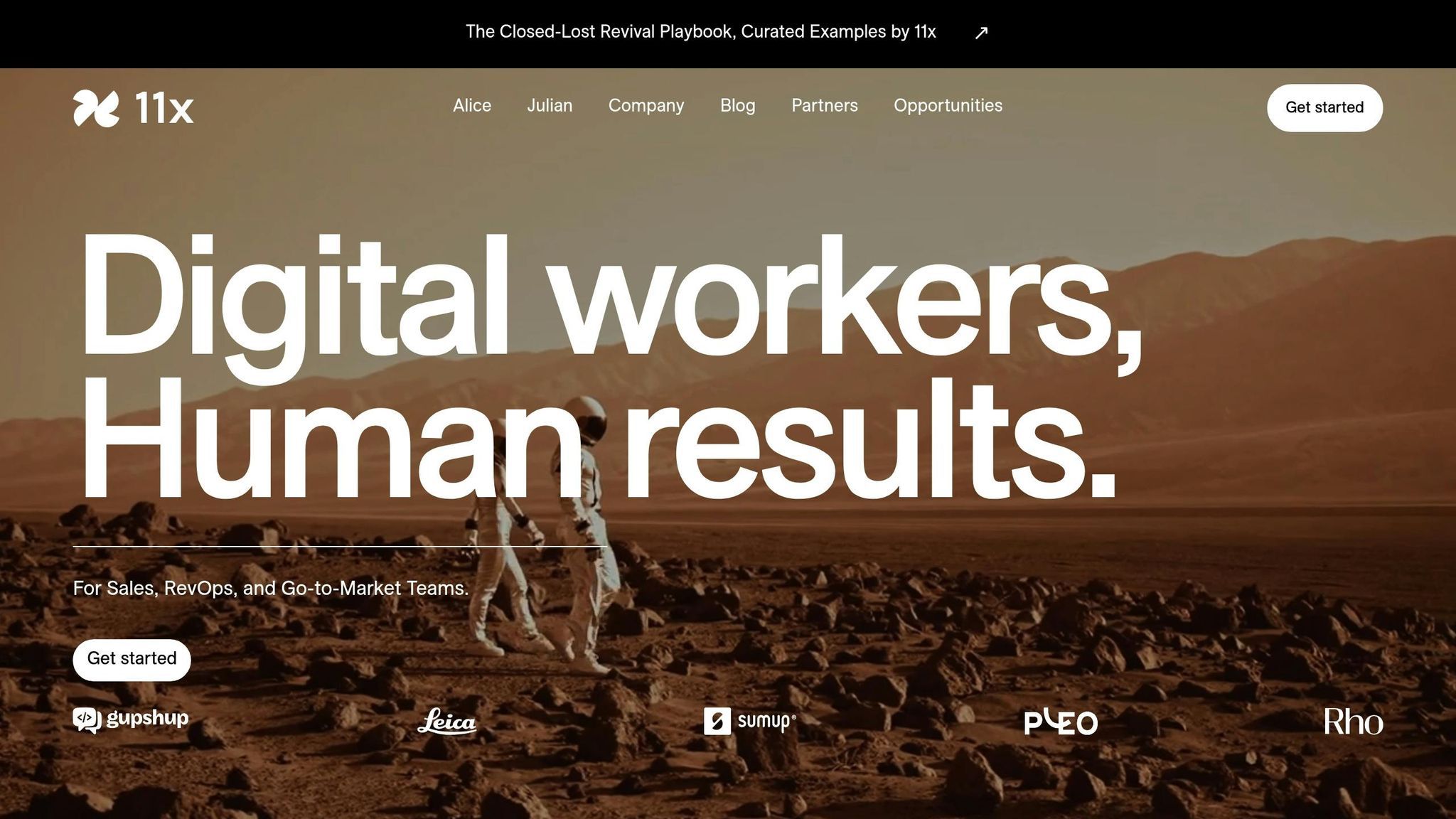
11x offers an AI-driven sales development platform designed to take B2B outreach to the next level through smart automation and tailored engagement. Unlike traditional tools, it focuses on autonomous prospecting and managing multi-touch campaigns. By using advanced machine learning algorithms, it identifies high-intent prospects and fine-tunes outreach timing across multiple channels like email, LinkedIn, and phone.
What sets 11x apart is its predictive lead scoring system. This feature evaluates buyer behavior and company growth signals, helping sales teams focus on prospects with the highest likelihood of converting. Additionally, its AI-powered personalization engine crafts messages that feel relevant and timely. By analyzing prospect data, recent company updates, and industry trends, it ensures every interaction feels genuine and well-timed. With these standout features, 11x is a strong contender in the world of advanced AI sales development tools.
3. SecondBrain Labs
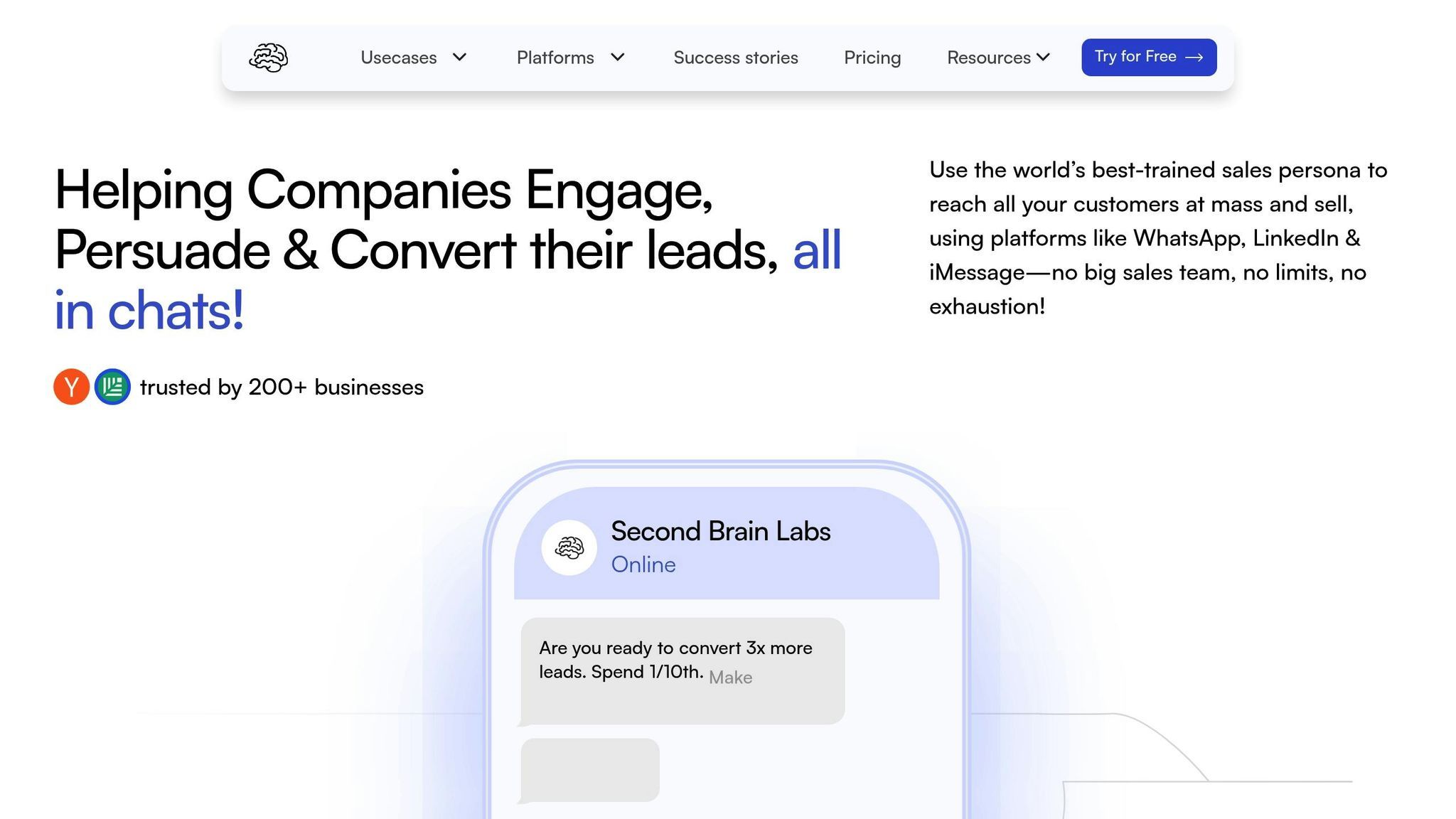
At this point, detailed and verified information about the features of SecondBrain Labs is not available. There’s no mention of specifics regarding automation, outreach, lead generation, or personalization. For the most accurate and up-to-date details, it’s best to consult SecondBrain Labs directly.
4. Persana
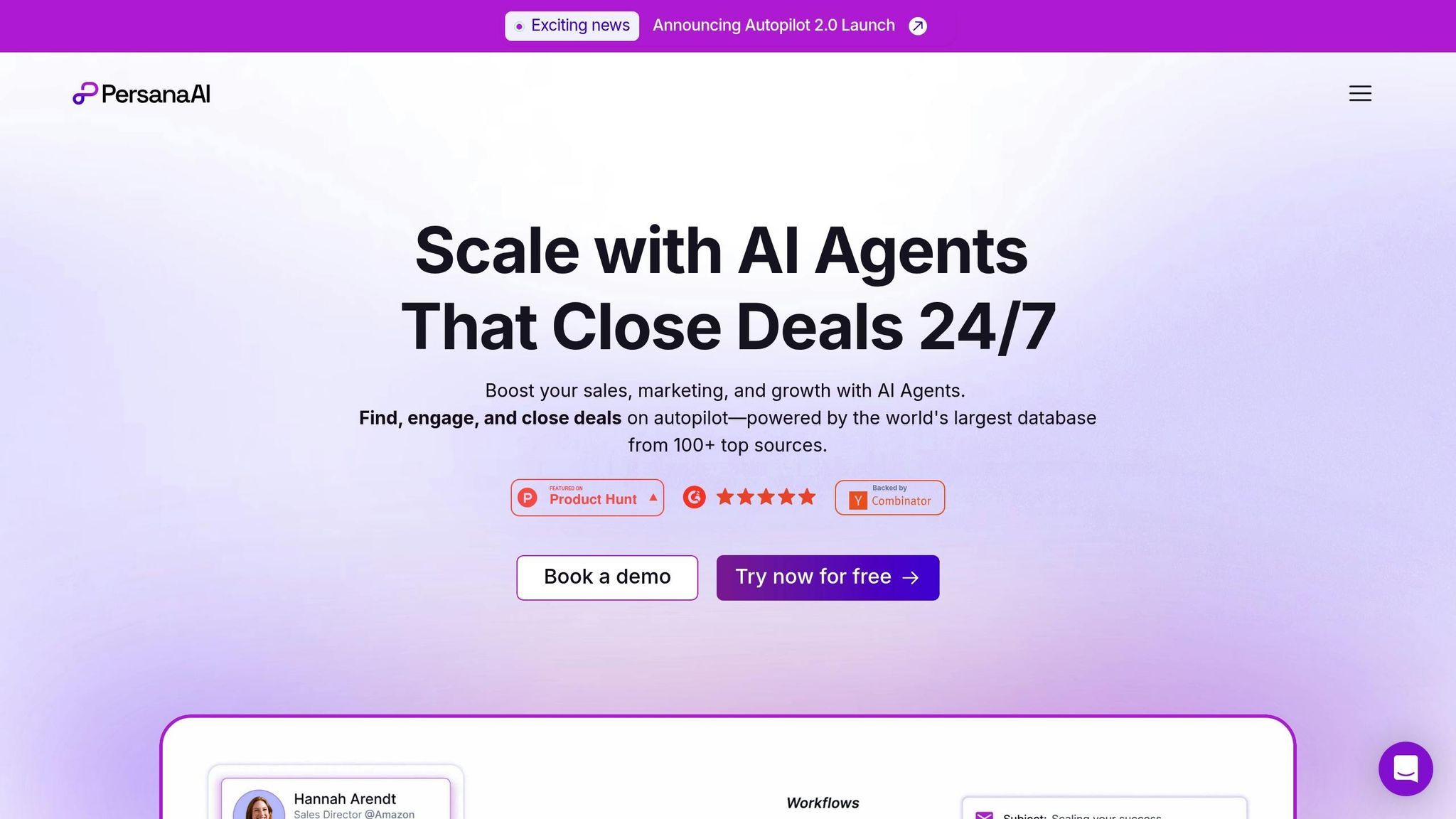
Persana stands out as a powerful AI-driven tool designed to make sales prospecting more efficient for B2B teams. It simplifies the process of finding and engaging with high-quality prospects, helping sales teams focus on what matters most - building connections that drive results.
One of Persana's key strengths is its ability to automate time-consuming tasks. From intelligent prospect research to automated follow-up sequences, the platform reduces manual work without compromising the quality of engagement. Its multi-channel outreach feature ensures sales teams can run coordinated campaigns across email, LinkedIn, and other platforms, keeping messaging consistent throughout the entire prospecting journey.
What truly sets Persana apart is its advanced lead scoring system. By analyzing buyer intent signals and company data, it prioritizes prospects with the best chances of converting. On top of that, its AI-powered personalization engine crafts messages tailored to each prospect. Using insights like recent company updates and industry trends, Persana helps sales teams create messages that feel genuine and relevant, strengthening connections with potential clients.
With these tools, Persana becomes an essential platform for sales teams looking to boost their efficiency while maintaining the personal touch that drives successful B2B relationships.
5. Cognism
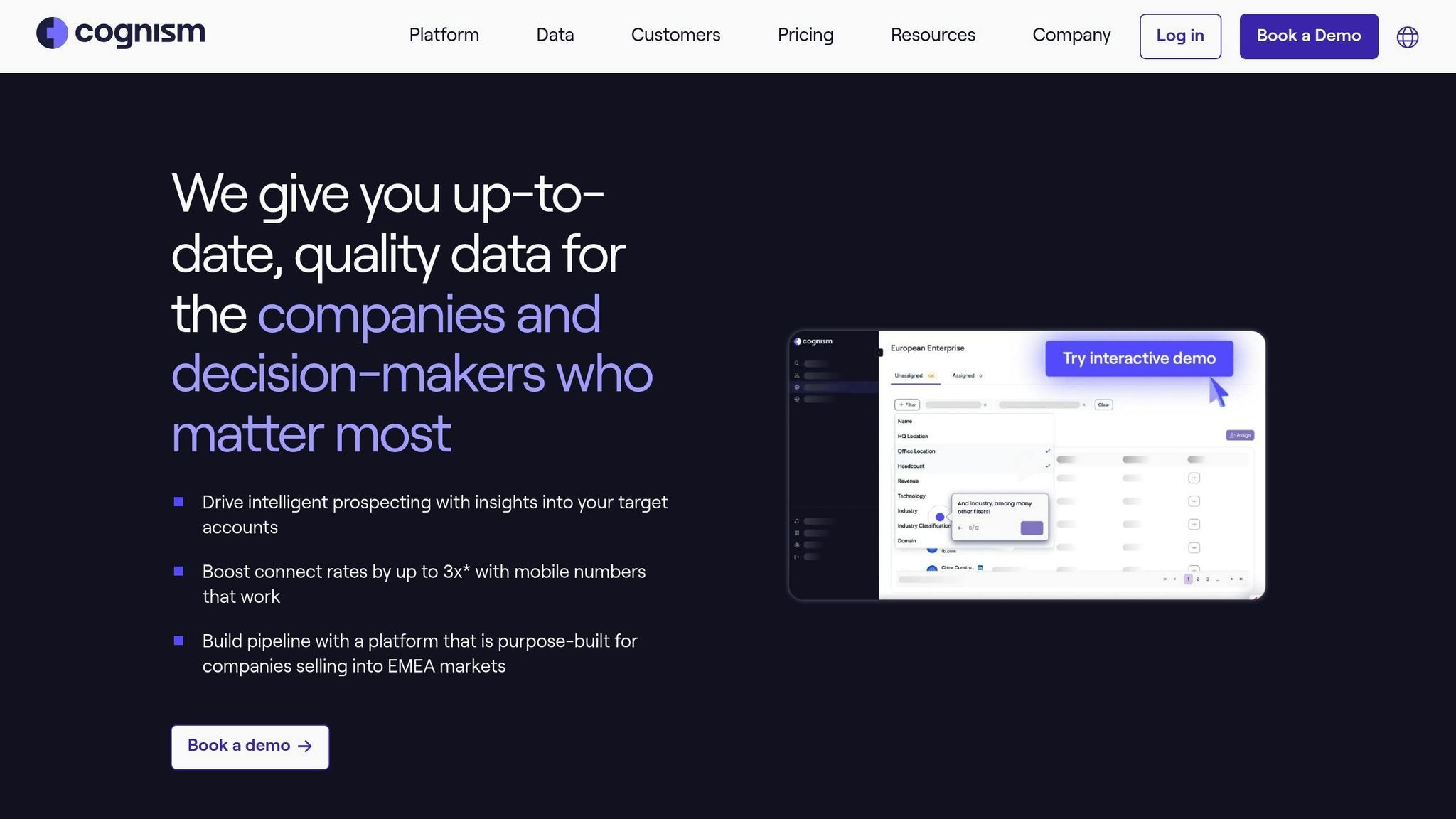
Cognism takes a data-driven approach to B2B sales prospecting, blending GDPR‑compliant contact data with real‑time buyer intent signals. Its primary goal? To provide high-quality prospect information that minimizes bounce rates and maximizes outbound campaign success.
Lead Generation Efficiency
At the heart of Cognism’s capabilities is its Diamond Data® verification system, which boasts an impressive 87% connection rate for mobile numbers[2]. This precision translates directly into results - Cognism’s cold call conversion rate is 6.7%[2], far surpassing the industry average of 2.3%[3].
The platform’s Sales Companion feature combines accurate contact details with real-time intent data, helping sales teams zero in on high-value prospects. As Coach Casey, a Sales Manager at Cognism, explains:
"Cold calling is still the most effective channel for outbound success."
By using detailed technographics and staying updated with real-time insights, Cognism equips sales professionals to connect with decision-makers at the perfect time in their buying journey. This approach often transforms cold leads into warm, engaged prospects ready for meaningful conversations.
Cognism also applies these insights to fuel a multi-channel engagement strategy, further enhancing lead quality and conversion potential.
Multi‑channel Outreach
Cognism doesn’t stop at lead generation - it extends its impact through multi-channel outreach. With foundational data tailored for email, phone, and LinkedIn, the platform ensures seamless integration with tools like Salesforce and other CRMs. This smooth data flow allows sales teams to execute coordinated campaigns across multiple channels.
The company’s own sales strategy in 2025 highlights this approach. Teams prioritize phone-first campaigns while incorporating email and LinkedIn touchpoints for a well-rounded engagement sequence. Multithreading capabilities, which involve reaching multiple stakeholders within a target account, amplify these efforts. The results speak for themselves: phone-based reps average 6.8 quality conversations per day, compared to 3.3 for email-focused reps[3].
"Cognism is unique because it combines GDPR‑compliant data, intent signals, technographics, and real‑time updates." – Cognism [1]
Additionally, Cognism’s CRM integrations keep prospect interactions and updates in sync across all channels, ensuring no effort is wasted on duplicate outreach. This comprehensive approach streamlines sales processes and maximizes engagement potential.
sbb-itb-4c49dbd
6. Outreach.io
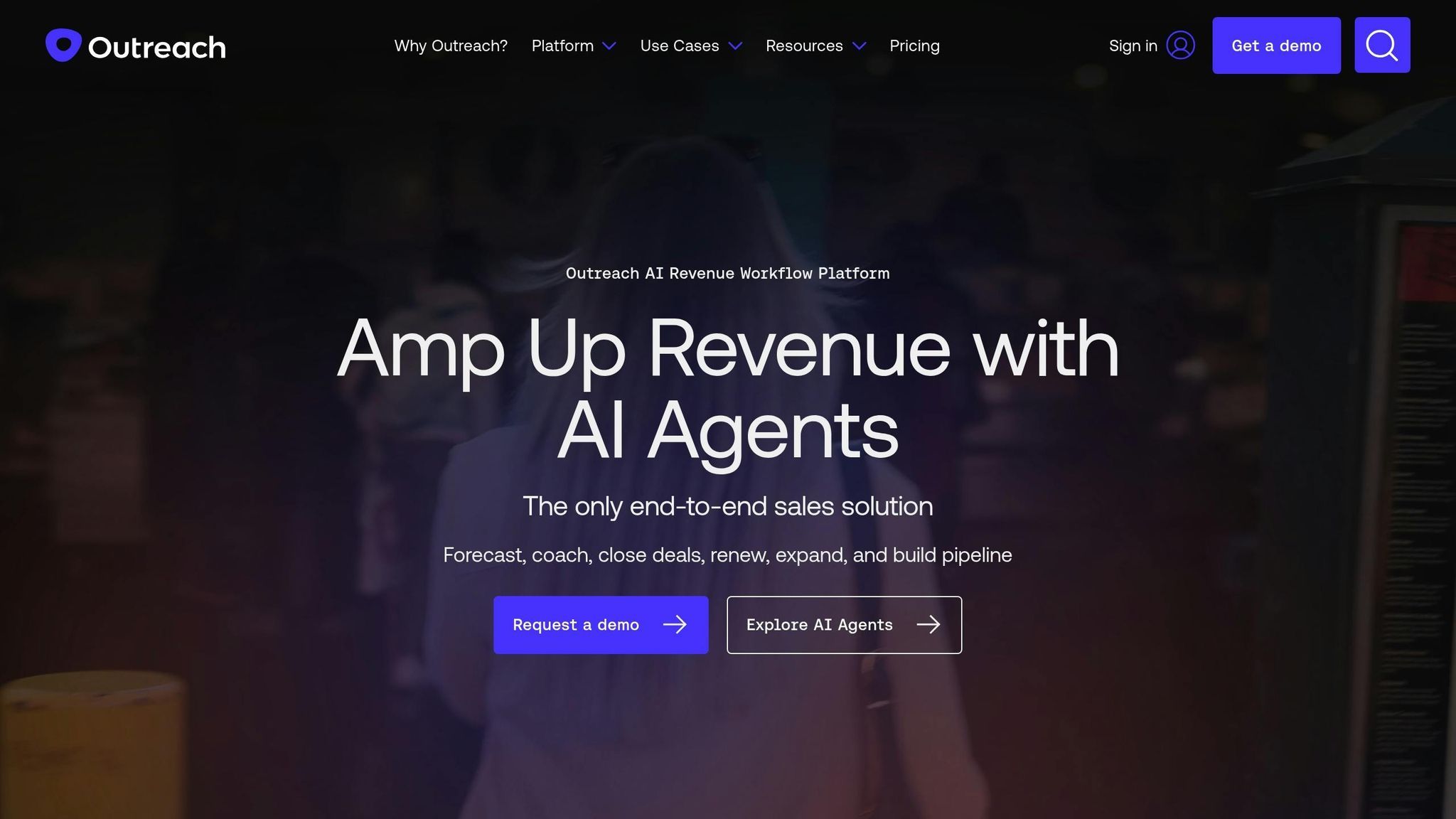
Outreach.io stands out as a platform designed to enhance sales execution by combining automation with AI-driven insights. It simplifies B2B revenue workflows, acting as a central hub for managing sales processes and team collaboration.
Automation Features
One of Outreach.io's standout features is Smart Sequences, which allows sales teams to create detailed, multi-step workflows. These workflows adapt based on how prospects engage. For instance, sequences can pause if a prospect shows renewed interest, adjust follow-up schedules for different time zones, or trigger specific actions based on engagement levels.
The platform goes beyond just email scheduling. It automates repetitive tasks like setting call reminders, managing outreach schedules, and syncing with calendar systems to propose meeting times, send confirmations, and handle follow-ups seamlessly.
Multi-Channel Communication
With Outreach.io, sales teams can coordinate their efforts across multiple channels, including email, phone, LinkedIn, and SMS. This multi-channel approach ensures consistent and synchronized messaging. Built-in collaboration tools also provide full visibility into team activities, helping avoid redundant efforts or miscommunication.
AI-Powered Personalization
Outreach.io uses AI to help sales teams craft personalized communication strategies. By analyzing past interactions and prospect behavior, the platform suggests tailored messaging and follow-up actions. This ensures that outreach efforts resonate with each prospect's unique needs, making communication more effective and meaningful.
7. SalesLoft
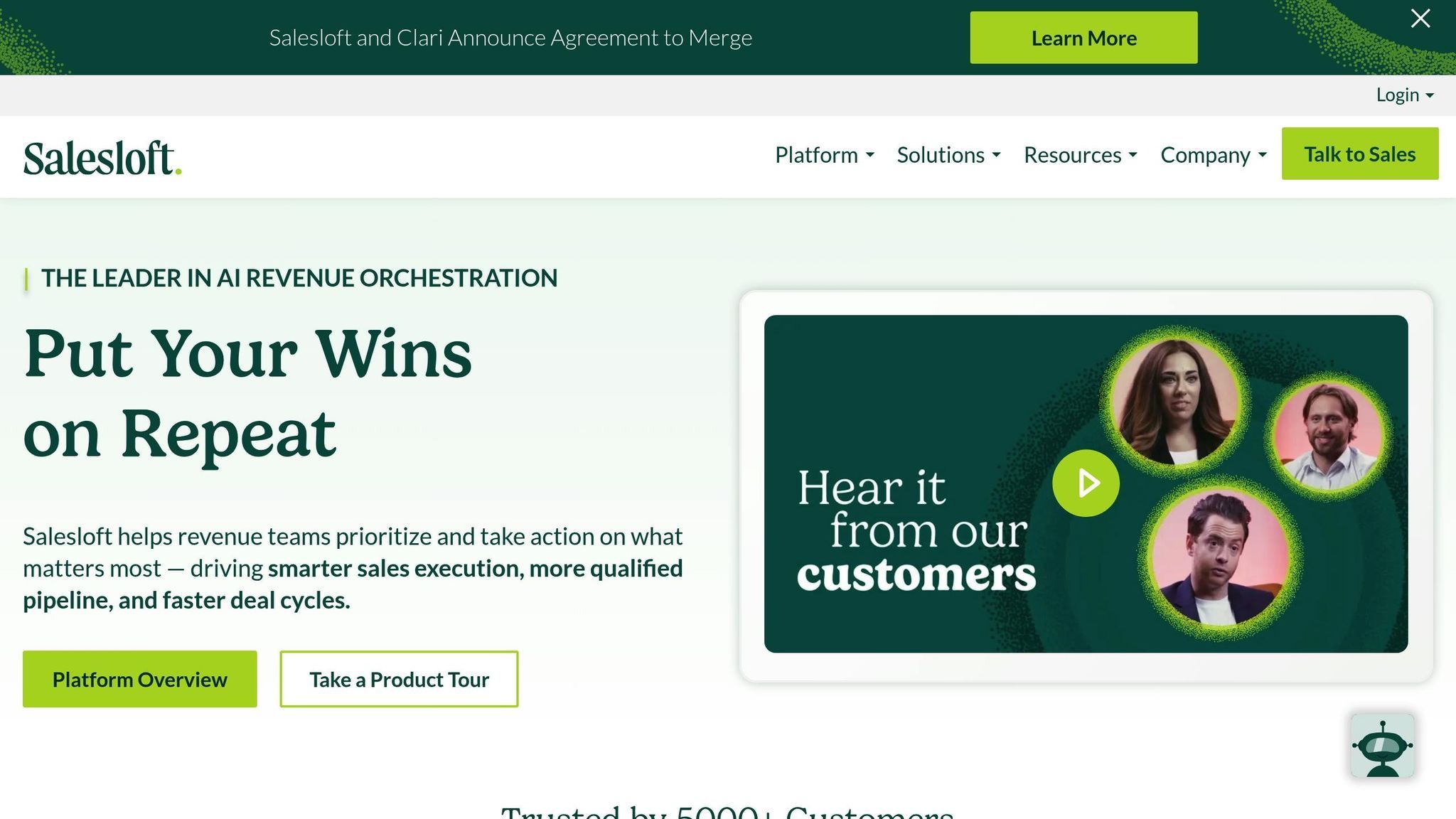
SalesLoft is an AI-powered platform designed to streamline and enhance B2B sales operations. It combines automation, multi-channel engagement, and personalized interactions to help sales teams work more efficiently while maintaining a human touch.
Automation Capabilities
SalesLoft simplifies repetitive tasks and provides actionable insights through its 26 AI agents, which operate across the entire revenue cycle. These agents prioritize deals, interpret key signals, and take timely actions, allowing sales teams to focus on strategic selling at scale [4].
With its No-Code Signals and Custom Plays, SalesLoft enables teams to transform internal data into automated workflows - eliminating the need for APIs or engineering support. This feature allows sales teams to trigger automated actions based on any account, person, or opportunity field, creating highly customized workflows [4][5].
The platform’s Cadence tool further optimizes outreach by enabling teams to schedule follow-ups and create personalized email templates. Automation rules ensure smooth transitions between cadences, triggered by actions like replies, link clicks, calls, meetings, or completed cadences [6][8].
SalesLoft also simplifies scheduling and securely manages contact details. Its Account Team Sync feature integrates seamlessly with Salesforce, automatically syncing team member relationships for account filtering and task assignment within automation rules [7].
By combining these automation tools, SalesLoft ensures efficiency while freeing up sales teams for meaningful engagement.
Multi-Channel Outreach
SalesLoft facilitates consistent communication across a variety of channels, including email, phone, LinkedIn, and more. Its iPaaS integrations make it easy to connect external data from platforms like Snowflake or Databricks directly into SalesLoft workflows. This is achieved through integrations with tools such as Workato, Tray.io, or Zapier [4][5].
In addition, SalesLoft integrates with major CRM platforms like Salesforce, Microsoft Dynamics, and HubSpot. This ensures that all multi-channel interactions are tracked and aligned across the sales pipeline, making it easier for teams to manage and optimize outreach efforts [6].
AI-Driven Personalization
SalesLoft’s AI capabilities enhance personalization, ensuring every interaction feels tailored to the prospect. Its AI agents provide intelligent, timely recommendations within the workflow, helping sales teams refine their strategies.
The platform’s Conversation Intelligence feature offers deeper insights by analyzing sales calls, extracting valuable data, and generating detailed reports. It includes bulk authentication and auto-recording for Zoom and Microsoft Teams, ensuring that crucial call data is captured and analyzed [4][5][7]. Additionally, missed calls are automatically logged and displayed in the Activity Feed on the Person Profile Page, ensuring no interaction slips through the cracks [7].
8. Drift
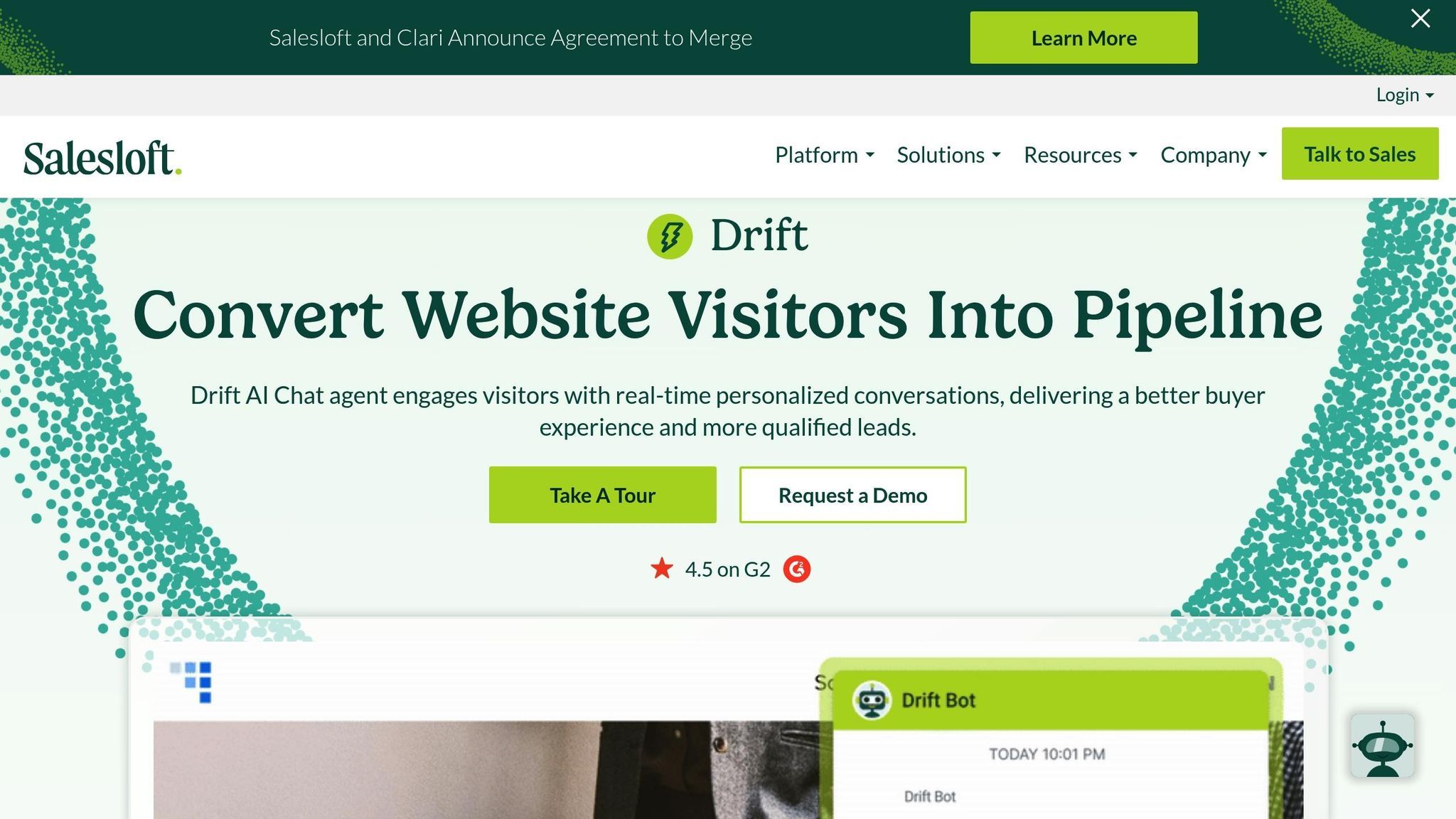
Drift uses AI-driven chatbots to connect with website visitors and qualify leads for sales teams, ensuring businesses can engage potential customers when their interest is at its highest. By doing so, companies can capture leads the moment visitors land on their site. According to user reports, this approach has led to a 25% increase in lead generation and a 30% faster sales cycle[9]. A study by Drift also revealed that 58% of businesses take over five minutes to respond to inquiries, which can result in lost opportunities[9]. Drift’s focus on real-time engagement aligns with the growing emphasis on AI-powered personalization, as discussed earlier.
Lead Generation Efficiency
Drift's approach highlights the importance of reducing response times and improving lead capture, a hallmark of AI-based sales tools. By responding instantly, the platform ensures businesses can seize those critical moments when a prospect’s interest is at its peak. This real-time interaction helps sales teams avoid the delays that often come with traditional follow-up methods, maximizing their ability to convert high-intent leads.
9. Apollo.io
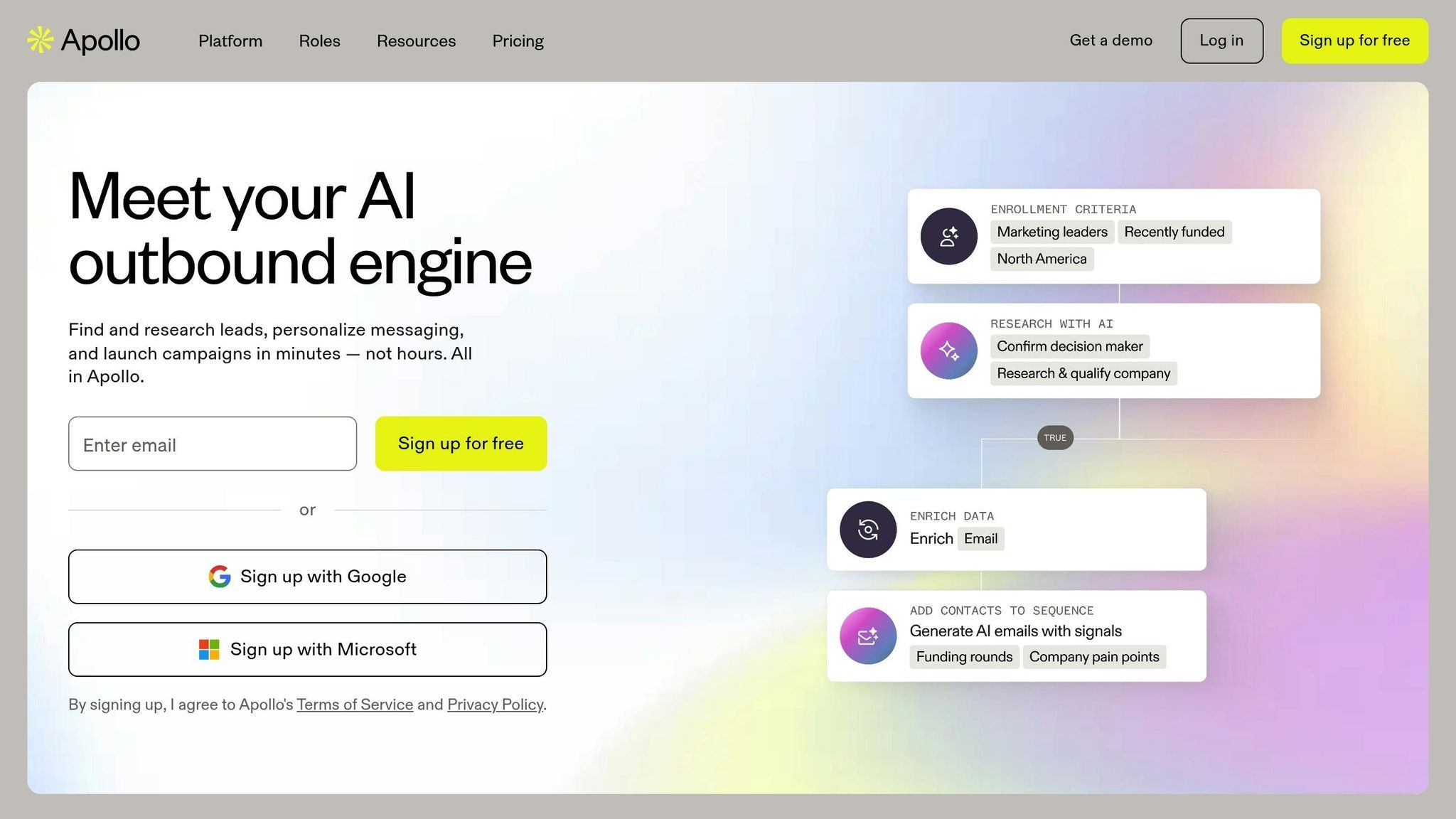
Apollo.io brings together prospecting, engagement, and analytics to simplify the B2B sales process. With a vast database of business contacts and powerful automation tools, it’s a go-to platform for generating leads and executing outreach campaigns efficiently. Sales teams can tap into a treasure trove of company and contact information, making it easier to connect with potential clients.
Automation Features
Apollo.io stands out with its automation capabilities, particularly its sequence-building tools. These sequences can automatically send personalized emails, LinkedIn messages, and even set phone call reminders based on how prospects interact with previous outreach. For instance, if a prospect opens an email but doesn’t reply, the system can send a follow-up message or prompt a LinkedIn connection request automatically.
The platform also includes an AI-powered email writer, which helps sales reps create tailored messages quickly. This is a game-changer for teams managing large contact lists, as it balances personalization with efficiency, saving time while maintaining a human touch.
Multi-channel Outreach
One of Apollo.io’s strengths is its ability to integrate multiple communication channels into a single workflow. Sales teams can combine email, LinkedIn, and phone calls within the same sequence for a seamless engagement strategy. With its Chrome extension, reps can even prospect directly from LinkedIn, automatically pulling contact details and adding them to sequences without leaving their browser.
This multi-channel approach not only ensures broader reach but also provides valuable insights. Teams can analyze which channels drive the best results and fine-tune their strategies to maximize campaign performance.
Smarter Lead Generation
Apollo.io makes finding the right leads easier with advanced filtering options. Users can narrow down prospects by factors like company size, industry, technology stack, or recent funding rounds to zero in on high-potential opportunities. Additionally, the platform’s email verification feature minimizes bounce rates by ensuring contact details are accurate.
Another standout feature is its intent data. Apollo.io identifies companies actively researching similar solutions, allowing sales teams to prioritize prospects who are more likely to be in the market for their products or services. This targeted approach boosts conversion rates and makes outreach efforts more effective.
AI-Powered Personalization
Apollo.io leverages AI to help sales reps craft messages that feel genuinely personalized. By analyzing prospect and company data, it suggests elements like recent news or job changes that can serve as conversation starters. This encourages reps to go beyond generic templates and create messages that resonate on a more personal level.
The platform’s conversation intelligence takes it a step further by analyzing email responses to identify which messaging strategies drive the most engagement. These insights allow teams to refine their approach, improving response rates and overall campaign success.
10. HubSpot Sales Hub
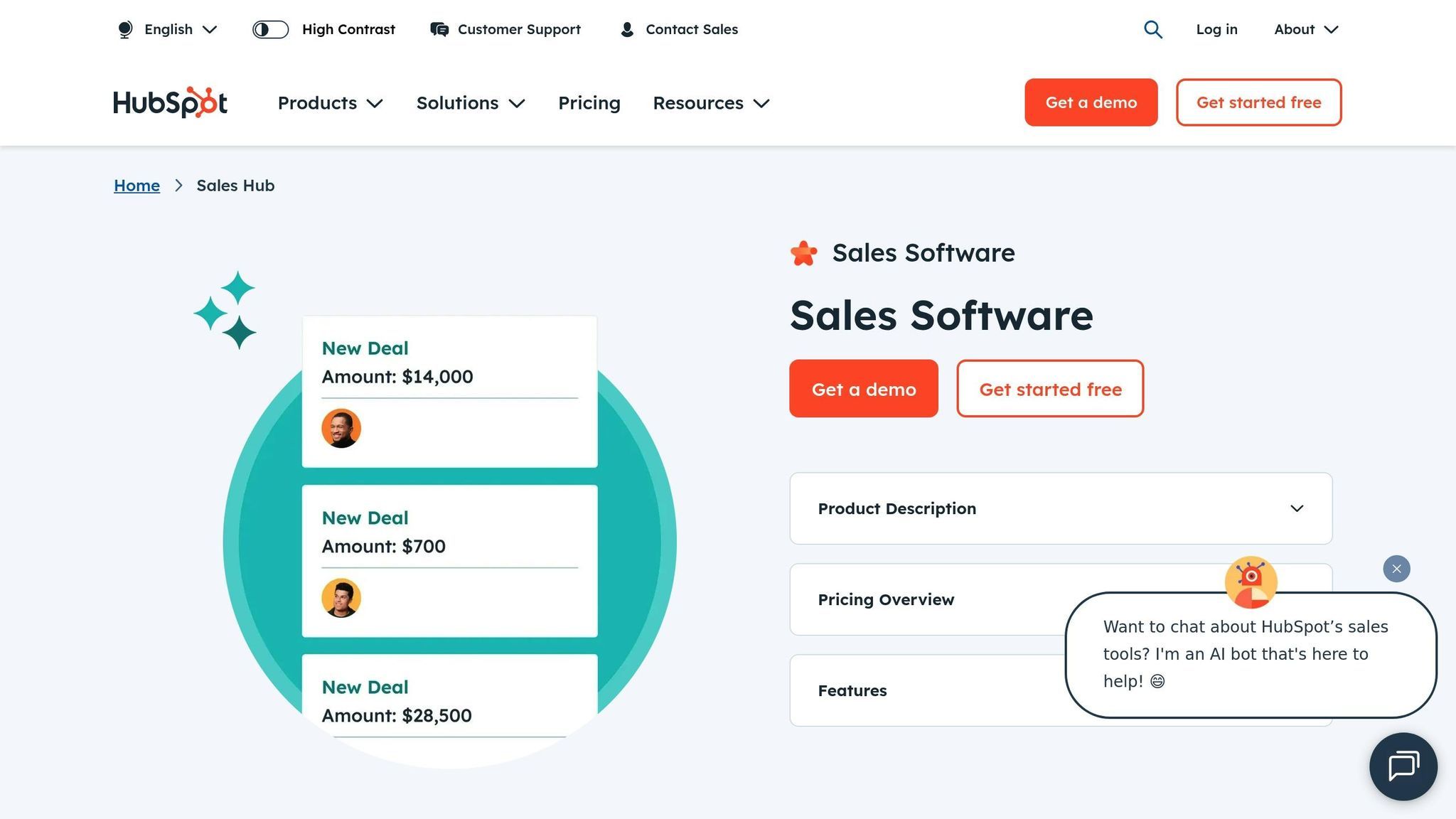
HubSpot Sales Hub wraps up our list as an all-in-one CRM sales platform that merges classic sales management with cutting-edge AI tools. By seamlessly connecting sales, marketing, and customer service, it provides a unified view of customer data across teams, which is especially useful for B2B organizations. Over time, the platform has added AI-driven tools to help sales teams work smarter while still preserving the personal touch that’s key to building strong business relationships.
Automation Capabilities
HubSpot Sales Hub simplifies repetitive tasks by automating multi-step email sequences and follow-up actions based on how prospects interact with your outreach. For instance, if a prospect opens an email, clicks a link, or visits a specific webpage, the system can automatically assign follow-up tasks or adjust the sequence. One standout feature is its ability to pause email sequences as soon as a prospect replies, ensuring your outreach doesn’t feel robotic or impersonal.
Here’s an example: when a deal reaches the "proposal sent" stage, HubSpot can schedule a follow-up task for three days later, reminding the sales rep to check in with the prospect.
The platform’s lead scoring automation is another game-changer. It evaluates both explicit data (like company size or industry) and implicit behaviors (such as website visits or email opens) to rank leads by their likelihood to convert. This ensures sales teams focus their time on high-priority prospects instead of chasing less promising leads.
Multi-channel Outreach
HubSpot Sales Hub takes a CRM-first approach to multi-channel outreach, making it easy to track interactions across email, phone calls, meetings, and even live chat on the company website. This creates a comprehensive timeline of each prospect’s journey.
The HubSpot Chrome extension is a handy tool for logging emails, calls, and LinkedIn interactions directly into contact records. This feature is especially valuable for B2B sales, where deals often involve multiple conversations over extended periods.
Scheduling meetings is also a breeze. Prospects can book time directly through email signatures or landing pages, with automatic confirmations and reminders reducing the back-and-forth of scheduling logistics.
Lead Generation Efficiency
HubSpot Sales Hub shines when it comes to integrating lead generation with marketing efforts. Instead of acting as a standalone tool, it pulls leads from forms, landing pages, and website chat, then routes them to the right sales reps based on criteria like territory or industry.
The company insights feature enriches contact records with publicly available details about prospects’ companies, such as recent news, funding updates, or their technology stack. This equips sales reps with conversation starters and context for more personalized outreach.
With website tracking, sales teams can see which prospects are actively browsing their site, including which pages they visit and how long they stay. This real-time data helps reps approach prospects when they’re most engaged and tailor their pitch to the specific solutions prospects are exploring.
AI-Driven Personalization
HubSpot’s AI tools are designed to make personalization more effective. Its conversation intelligence analyzes sales calls and emails to identify patterns in successful deals, giving reps insights into what messaging works best for different audiences.
The AI content assistant takes this further by suggesting case studies or sales materials tailored to the prospect’s industry, buying stage, or specific challenges. This ensures reps are always sharing content that speaks directly to the prospect’s needs.
Predictive lead scoring uses machine learning to analyze past deals and highlight the prospects most likely to close. It factors in engagement levels, company details, and behavioral trends, helping sales teams prioritize their efforts.
Lastly, HubSpot’s deal forecasting leverages AI to estimate close dates and deal values based on historical data and current pipeline activity. This gives sales managers a clearer picture of potential revenue and flags deals that may need extra attention to stay on track.
Feature Comparison Table
Finding the right AI SDR tool is crucial for optimizing B2B sales. Below is a detailed comparison of various tools, highlighting their key features, strengths, and limitations to help you make the best choice for your needs and budget.
| Tool Name | Automation Capabilities | Multi-Channel Outreach | Lead Generation Efficiency | Personalization | Integration Options | Pricing (USD) | Pros | Cons |
|---|---|---|---|---|---|---|---|---|
| AI SDR Shop | Curated directory with customizable workflows | Provides curated insights on outreach strategies (information-based) | Intent-driven lead identification and agent matching | Personalized tool recommendations with custom search filters | N/A | Free | Comprehensive directory with detailed agent profiles; free to use | Does not provide direct outreach automation |
| 11x | Intelligent workflow automation | Email, social media, phone | Real-time prospect identification | AI-driven message customization | Major CRMs and sales tools | N/A | Strong AI capabilities; scalable | Requires higher investment |
| SecondBrain Labs | Smart task automation | Email, LinkedIn outreach | Predictive lead qualification | Behavioral personalization | HubSpot, Salesforce | N/A | User-friendly interface; good value | Limited advanced features |
| Persana | Multi-step sequence automation | Email, LinkedIn, phone calls | Advanced lead enrichment | Dynamic personalization engine | Salesforce, HubSpot seamless integration | N/A | Strong personalization; reliable integrations | Moderate feature depth |
| Cognism | Basic automation workflows | Email, phone, LinkedIn | Comprehensive B2B database | Template-based personalization | Standard CRM connections | N/A | Excellent data quality; compliance-focused | Limited automation depth |
| Outreach.io | Enterprise-level automation | Email, phone, LinkedIn, SMS | Advanced analytics and reporting | AI-powered content suggestions | Salesforce, HubSpot, Dynamics continuous connection | N/A | Industry-leading features; strong CRM-native integration | Complex setup; high investment for scale |
| SalesLoft | Comprehensive automation suite | Email, phone, LinkedIn, video | Robust lead management | Conversation intelligence | Major CRM and marketing platforms | N/A | Strong enterprise features; excellent support | Steeper learning curve |
| Drift | Conversational automation | Live chat, email, video | Website visitor identification | Real-time personalization | Popular marketing and sales tools | N/A | Exceptional for inbound leads with conversational AI | Focused primarily on chat, which may limit outreach channels |
| Apollo.io | Sequence automation with A/B testing | Email, LinkedIn, phone | Built-in prospecting database | AI content generation | Salesforce, HubSpot smooth integration | N/A | Great value as an all-in-one platform | CRM functionality isn't fully developed and may require a standalone CRM for complex processes [10][11] |
| HubSpot Sales Hub | Multi-step email sequences with smart pausing | Email, phone, meetings, live chat | Marketing-integrated lead routing | AI content assistant with industry-specific suggestions | HubSpot CRM seamless integration | N/A | Excellent value with comprehensive CRM integration | Limited advanced automation compared to specialized platforms |
Key Feature Highlights
Integration and Automation:
Many tools stand out with their CRM integrations, ensuring smoother workflows. For instance, Outreach.io and SalesLoft provide advanced automation features tailored for enterprise needs. On the other hand, Apollo.io offers efficient workflows but may require a separate CRM for handling more intricate sales processes [10][11].
Lead Generation and Personalization:
Lead generation strategies vary significantly across these platforms. Cognism stands out with its extensive contact database and compliance-first approach, while Drift focuses on engaging website visitors through conversational AI. Personalization options range from basic templates to advanced AI-driven engines. For example, HubSpot's AI content assistant delivers industry-specific recommendations, and Persana adapts messaging dynamically based on behavioral data.
US B2B Sales Team Considerations
When selecting an AI SDR tool for a B2B sales team in the US, it's important to ensure the platform aligns with US-specific standards for data presentation and operational functionality. These considerations build on the basic features of such tools, tailoring them to meet the unique needs of US-based businesses.
Data Display Standards
Financial data should adhere to standard US formatting. This means dashboards and reports must display amounts in USD (e.g., $1,000.00) and follow the convention of using commas for thousand separators and periods for decimals (e.g., 1,000.50). Proper formatting ensures clarity and consistency for your team.
Date and Time Standardization
All date settings should follow the MM/DD/YYYY format across the tool’s features, such as follow-up reminders, meeting schedules, and analytics. This ensures uniformity and avoids confusion within your team.
Data Privacy and Compliance
Verify that the platform complies with CCPA and other relevant US regulations. This includes robust procedures for managing data deletion requests and opt-out options, ensuring your organization meets its legal obligations.
Time Zone Management
A good tool should accommodate scheduling across US time zones - Pacific, Mountain, Central, and Eastern. This ensures email campaigns and call reminders are sent during appropriate local business hours, improving engagement and efficiency.
Industry-Specific Needs
For teams operating in regulated industries like healthcare, finance, or government contracting, it's crucial to choose a tool that supports secure data transmission and provides detailed logging where required. This extra layer of security helps maintain compliance with industry standards.
Integration with US Business Systems
Ensure the platform integrates smoothly with US-standard systems like CRMs, accounting software, and communication tools. It should also support local requirements, such as US tax codes and proper phone number formatting, to keep operations running seamlessly.
Conclusion
By 2025, AI-powered SDR tools are transforming B2B sales, opening up new ways to simplify prospecting and drive revenue growth. These tools now come equipped with features like advanced personalization, multi-channel outreach coordination, and intelligent lead scoring.
But the real game-changer isn't just automation - it's precision. These platforms are designed to send the right messages to the right prospects at the right time. With capabilities such as real-time intent data analysis, dynamic personalization, and automated follow-ups, sales teams can stay engaged with prospects while dedicating their energy to high-impact tasks like closing deals and fostering relationships. This approach ensures that every interaction contributes meaningfully to the sales journey.
For sales teams in the US, choosing tools that align with local compliance standards, time zone management, and data security requirements is critical. Features that allow seamless campaign management across multiple time zones while safeguarding sensitive information are no longer optional - they’re essential.
Investing in AI SDR tools can lead to faster pipelines, higher-quality leads, and improved productivity. However, the key to success lies in selecting a platform that fits your team’s workflow, technical needs, and growth goals. Whether you're a startup seeking affordable automation or a large enterprise requiring advanced customization, there’s a solution available to meet your needs.
When evaluating platforms, prioritize those offering clear pricing, strong integration options, and reliable support. The most effective tools combine AI efficiency with human oversight, enhancing the personal touch rather than replacing it.
Ultimately, the right platform will seamlessly integrate with your processes, paving the way for sustained sales success in 2025 and beyond.
FAQs
How can AI SDR tools help B2B sales teams generate leads and create personalized outreach?
AI SDR tools make life easier for B2B sales teams by taking over some of the most time-consuming tasks, like researching prospects and qualifying leads. Using AI-driven insights, these tools can quickly pinpoint prospects with high potential, making the process faster and more efficient. What’s more, these tools excel at creating highly personalized outreach. By analyzing prospect data, they can craft tailored messages and even automate communication across multiple channels. This means sales teams can spend less time on repetitive tasks and more time building meaningful connections with potential customers - ultimately boosting lead conversion rates and saving valuable time.
What features should B2B sales teams focus on when choosing an AI SDR tool in 2025?
In 2025, B2B sales teams should focus on AI-powered SDR tools designed to make their workflows smoother and deliver better outcomes. Look for tools that offer advanced automation, multi-channel outreach, and AI-driven personalization. These features can handle tasks like simplifying lead generation, fine-tuning email sequences, and automating repetitive work - freeing up sales reps to concentrate on building connections and closing deals. When evaluating tools, prioritize features like natural language processing (NLP) for smarter lead qualification, machine learning to enhance outreach tactics, and access to comprehensive contact databases. Tools that provide intelligent workflow automation and real-time insights can speed up processes, improve team efficiency, and boost engagement, ultimately driving higher conversion rates.
How do AI SDR tools stay compliant with data privacy laws like GDPR and CCPA?
AI SDR tools help businesses stay aligned with data privacy laws like GDPR and CCPA by embedding advanced safeguards into their operations. They use AI-powered methods such as data anonymization, classification, and secure data mapping to protect sensitive information. These tools follow privacy-by-design principles, meaning compliance is baked into their foundational processes. Many also offer features like automated privacy management and risk assessment, ensuring personal data is handled securely and transparently to meet legal requirements.